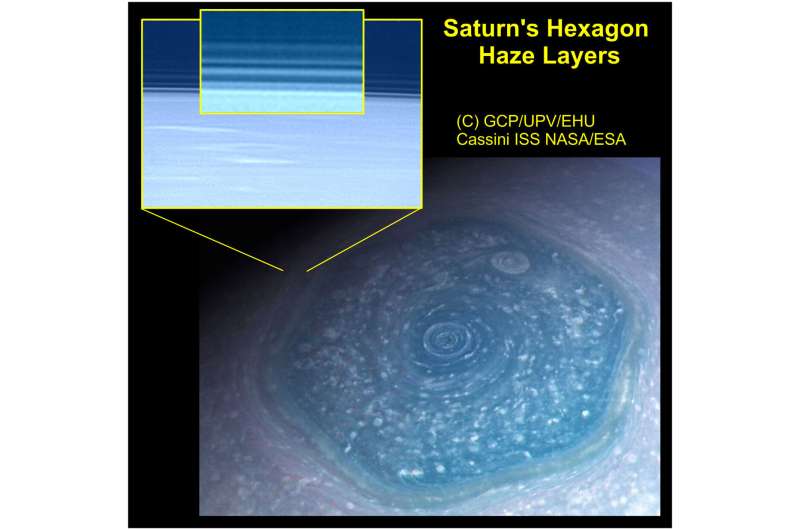Credit: University of the Basque Country
A rich variety of meteorological phenomena takes place in the extensive hydrogen atmosphere of Saturn, a world about 10 times the size of the Earth. They help us to better understand similar features in the Earth's atmosphere. Among Saturn's atmospheric phenomena is the well-known "hexagon," an amazing wave structure that surrounds the planet's polar region.
Discovered in 1980 by NASA's Voyager 1 and 2 spacecraft, it has been observed without interruption since then, despite the planet's long, strong cycle of seasons. A fast, narrow jet stream flows inside this gigantic planetary wave where winds reach maximum speeds of about 400 km/h. Yet, strangely enough, the wave itself remains almost static; in other words, it barely shifts with respect to the planet's rotation. All these properties mean that the "hexagon" is a highly attractive phenomenon for meteorologists and planet atmosphere researchers.
Cassini, which was in orbit around the planet between 2004 and 2017, took a large quantity of images from a range of distances from the planet and viewing angles. In June 2015, its main camera obtained very high-resolution images of the planet's limb, which are capable of resolving details of between 1 and 2 km; they captured the haze located above the clouds of the hexagonal wave. In addition, they used many colour filters, from ultraviolet to near infrared, thus allowing researchers to study the composition of the haze. To complete this study, the researchers incorporated images produced by the Hubble Space Telescope taken 15 days later and showing the hexagon from above.
"The Cassini images have enabled us to discover that, just like a sandwich, the hexagon has a multi-layered system of at least seven mists that extend from the summit of its clouds to an altitude of more than 300 km above them," said Professor Agustín Sánchez-Lavega, who led the study. "Other cold worlds, such as Saturn's satellite Titan or the dwarf planet Pluto, also have layers of haze, but not in such numbers nor as regularly spaced out."
The vertical extent of each haze layer is between approximately 7 and 18 km thick, and according to spectral analysis, they contain minute particles with radii on the order of 1 micron. Their chemical composition is exotic owing to the low temperatures in Saturn's atmosphere ranging between -120 degrees C and -180 degrees, they could comprise hydrocarbon ice crystallites such as acetylene, propyne, propane, diacetylene or even butane in the highest clouds.
The team also noted the regularity in the vertical distribution of the haze layers. They hypothesize that the haze layers are organized by the vertical propagation of gravity waves that produce oscillations in the density and temperature of the atmosphere, a well-known phenomenon on Earth and other planets. The researchers raise the possibility that it could be the very dynamics of the hexagon itself and its powerful jet stream that are responsible for these gravity waves. On the Earth, researchers have observed waves of this type produced by the undulating jet stream traveling at speeds of 100 km/h from west to east in the mid-latitudes. The phenomenon could be similar on both planets, even though the peculiarities of Saturn mean that it is the only case in the solar system. This is an aspect that remains subject to future research.
More information: A. Sánchez-Lavega et al, Multilayer hazes over Saturn's hexagon from Cassini ISS limb images, Nature Communications (2020). DOI: 10.1038/s41467-020-16110-1
Journal information: Nature Communications
Provided by University of the Basque Country
























